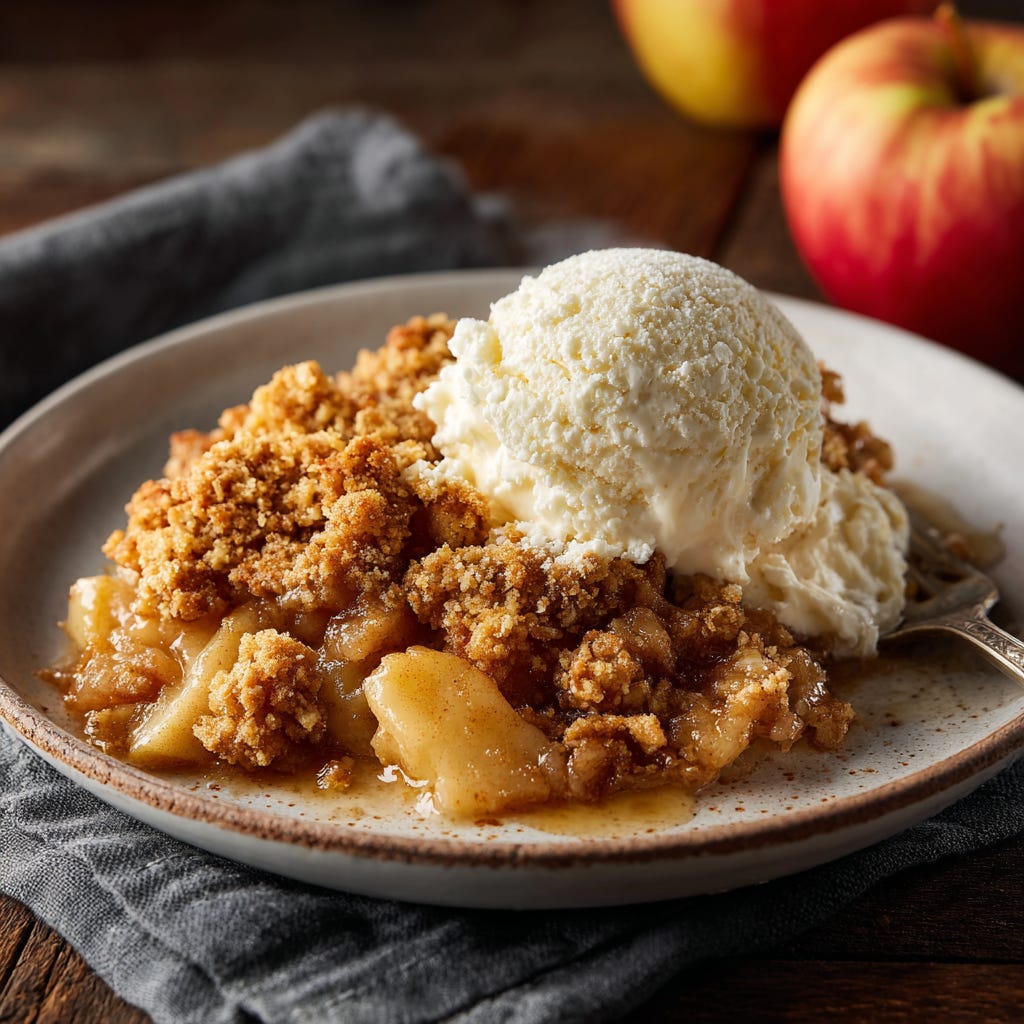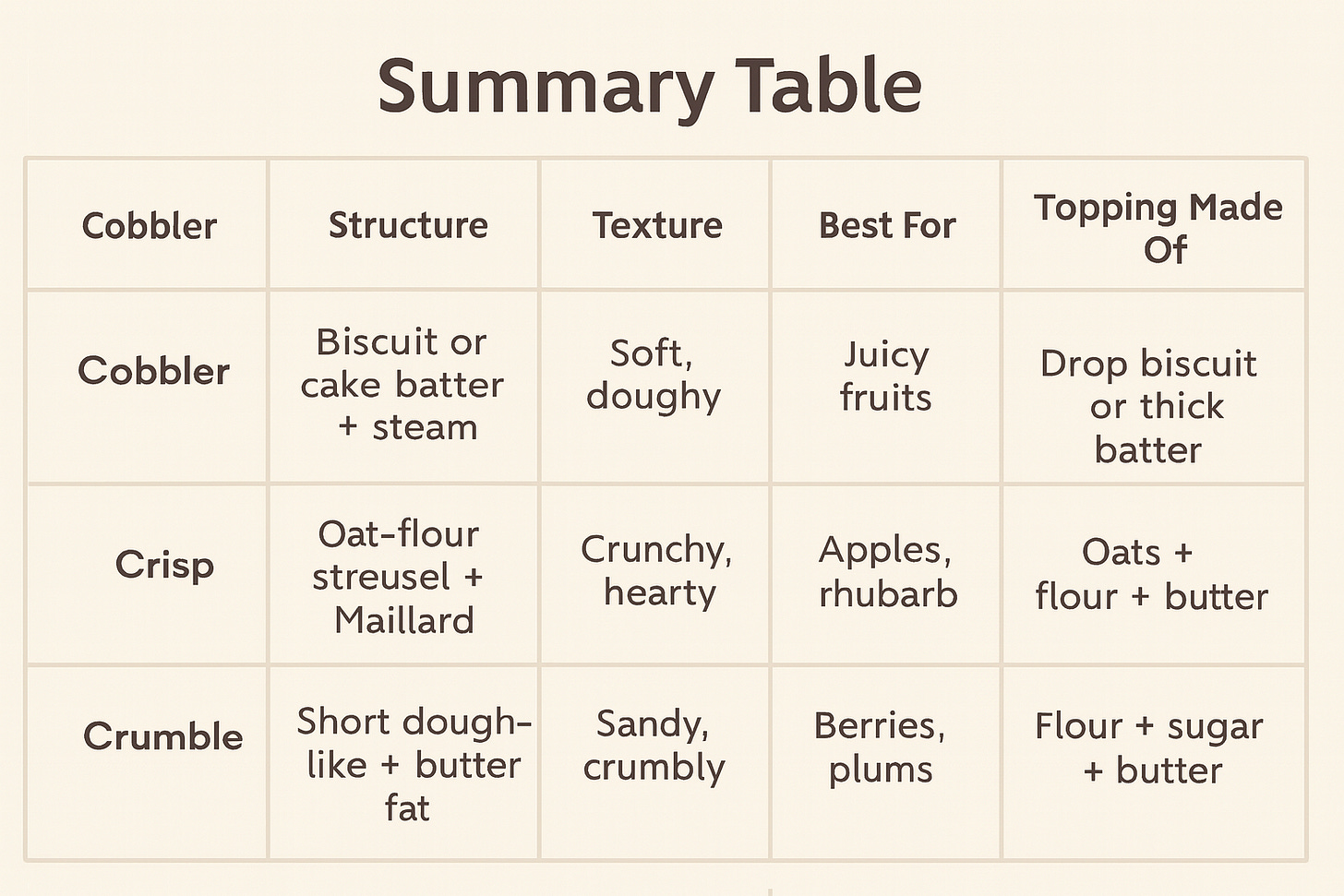As summer begins to wind down and late-season fruits reach their juicy peak, it's the perfect time to make one of my favorite — and, in my opinion, easiest — warm desserts: cobblers, crisps, and crumbles. These bakes are simple, crowd-pleasing, and ideal for feeding a group. My personal favorite? Anything with peach or nectarine and definitely cherry!
While these three desserts are often lumped together, their mouthfeel and structure are very different. Knowing the difference means you can bake with intention, whether you’re after crunch, crumble, or full-on comfort.
🍑 Cobbler
Ingredients: Biscuit dough or cake batter with a fruit base
Texture: Soft and doughy with a light crisp on top
Structure: Flour-based batter or dough + steam-leavened topping
Best For: Juicy fruits like peaches, nectarines, cherries
Cobblers rely on a hydrated flour network — usually a biscuit-style dough with some fat, liquid, and leavening (like baking powder). As it bakes, steam from the fruit filling lifts the dough, creating a pillowy structure. The flour’s gluten network sets upon cooling, while fats limit excessive toughness. A cobbler is a distinct fruit dessert due to their drop-style or layered dough.
Think of it like: A fruit stew with a biscuit dumpling on top.
🍎 Crisp
Ingredients: Oats, flour, brown sugar, butter, and a fruit base
Texture: Crunchy, coarse, crisp
Structure: Fat-shortened oat-flour streusel with Maillard browning
Best For: Apples, pears, rhubarb, berries
The key to a crisp is fat-inhibited gluten formation. Butter coats the flour and oats, preventing a dough from forming and encouraging a crumbly texture. Oats increase surface area and crispness, while sugar promotes caramelization. Browning via the Maillard reaction occurs between the milk solids in butter and the sugars when heated contribute to the complex flavors and that golden brown crunch.
Think of it like: Granola meets fruit pie.
🍓 Crumble
Ingredients: Butter, flour, sugar, and a fruit base without oats
Texture: Crumbly, sandy, tender
Structure: Short dough-style topping with fat dispersed throughout
Best For: Berries, plums, mixed fruits
A crumble is essentially a pared-down version of a crisp—no oats, just a fine, soft crumb. Its texture hinges on the butter-to-flour ratio: more fat means a softer, more tender bite. The topping forms when fat is mechanically worked into flour, much like shortbread. Butter’s milkfat not only brings rich flavor and a melt-in-the-mouth feel, but also makes the topping more perishable once it absorbs moisture from the fruit.
Think of it like: A deconstructed shortbread cookie over jammy fruit.
Why Does It Matter?
Understanding these differences is more than just a culinary exercise — it connects directly to food safety and quality.
Storage: The FDA Food Code advises storing fruit desserts at safe temperatures below 40°F (4°C) to prevent bacterial growth after baking.
Final Thoughts
So, next time you’re craving a warm fruit dessert, you can impress friends with your knowledge:
Want a soft biscuit topping? Go cobbler.
Want a crunchy, nutty topping? Go crisp.
Want something buttery and crumbly? Go crumble.
Are you team cobbler, crisp, or crumble? Or maybe you have your own twist on one of them? Reply and tell me—I’m always looking for new ideas to bake (and taste test).
Stay sweet,
Sarah @halfbatchbaking
📚 References:
USDA Food Standards & Dessert Definitions: usda.gov
FDA Food Code – Dairy & Butter Guidelines: fda.gov
ScienceDirect – Baking Science & Fat Functionality: sciencedirect.com
NIH – Carbohydrate & Lipid Interactions in Baked Goods:nih.gov





I love this breakdown - I feel both hungry & educated now ;-)
Enjoyed the article. Found it very helpful. So now I know which I really prefer! A Crumble or a Cobbler!